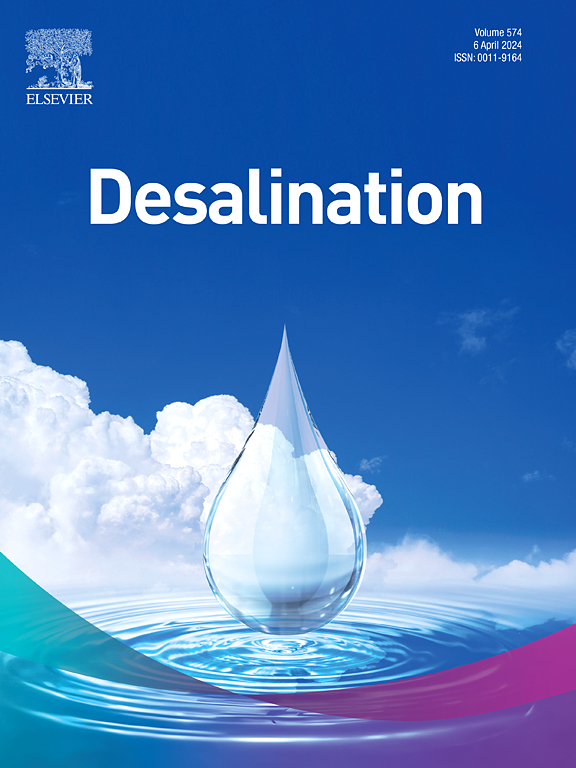Remediation of crude oil contaminated oily wastewater using nanostructured ZnO-decorated ceramic membrane: Membrane fouling and their mitigation using photo-catalytic self-cleaning process
IF 8.3
1区 工程技术
Q1 ENGINEERING, CHEMICAL
引用次数: 0
Abstract
In membrane-based oil water separation, the fouling of oil on the membrane pores due to the adsorption of oily feed components (crude oil) is a major disadvantage. In order to address the problem of membrane fouling, in this work, the filtration membrane itself was coated with a photoactive semiconducting material to self-clean the fouled membrane by photo-catalytic degradation. In addition to the self-cleaning, the other major functionality of the coating is to render a favorable surface wettability, conducive for water passing oil water separation. The basic membrane is porous alumina (Al2O3) substrate, on which a layer of crystalline Zinc Oxide (ZnO) thin film was coated by single step RF magnetron sputtering. The fabricated membrane is super-hydrophilic in the air and super-oleophobic underwater, and this contrasting wettability is crucial for the water passing oil water separation. The advantage of preferentially water passing membrane is that the oil clogging on the membrane surface is less than that of the oil passing membrane. However, after prolonged use with crude oil-contaminated feed, the accumulation of organic pollutants on the membrane surface hinders the smooth permeation of water through the membrane. The oil water filtration system involves cross flow through the ZnO-deposited Al2O3 membrane with the application of trans-membrane pressure. The membrane achieved an excellent separation efficiency (99.66 %) of oil and water from the oil emulsified water, and high permeates flux (908.4 L/m2.h.bar) for 200 ppm crude oil contaminated oily feed (surfactant stabilized crude oil-in-water emulsion). After a prolonged use of 540 min, the permeate flux declined due to the accumulation of organic pollutants present in the oily water. The original flux was restored by initiating photocatalytic degradation of organic pollutants by the exposure of UV radiation on the used membrane surface. The ZnO-deposited Al2O3 membrane shows an excellent light induced photocatalytic self-cleaning and antifouling with flux recovery ratio of around 88 %. In addition to this application, this manuscript also presents the morphological, elemental, structural, and topological characterizations of coated membrane.

纳米结构zno修饰陶瓷膜修复原油污染含油废水:膜污染及其光催化自清洁工艺的缓解
在膜基油水分离中,油类原料组分(原油)的吸附导致油在膜孔上的污染是一大缺点。为了解决膜污染问题,本研究在过滤膜上涂覆光活性半导体材料,通过光催化降解对污染膜进行自清洁。除了自清洁外,涂层的另一个主要功能是提供良好的表面润湿性,有利于水通过油水分离。基本膜是多孔氧化铝(Al2O3)衬底,在衬底上采用单步射频磁控溅射镀覆一层结晶氧化锌(ZnO)薄膜。制备的膜在空气中具有超亲水性,在水下具有超疏油性,这种不同的润湿性对通过油水分离的水至关重要。优先通水膜的优点是膜表面的油堵塞比通油膜少。然而,在与原油污染的饲料长期使用后,有机污染物在膜表面的积累阻碍了水通过膜的顺利渗透。油水过滤系统是在跨膜压力作用下通过zno沉积Al2O3膜的交叉流动。该膜对油乳化水中的油水分离效率达到99.66%,对200ppm原油污染的含油原料(表面活性剂稳定的原油水包乳)具有较高的渗透通量(908.4 L/m2.h.bar)。在长时间使用540分钟后,由于含油水中存在的有机污染物的积累,渗透通量下降。利用紫外辐射照射旧膜表面,启动光催化降解有机污染物,恢复了原有的通量。zno沉积的Al2O3膜具有良好的光催化自清洁和防污性能,通量回收率约为88%。除了这个应用之外,这份手稿还介绍了涂覆膜的形态、元素、结构和拓扑特征。
本文章由计算机程序翻译,如有差异,请以英文原文为准。
求助全文
约1分钟内获得全文
求助全文
来源期刊

Desalination
工程技术-工程:化工
CiteScore
14.60
自引率
20.20%
发文量
619
审稿时长
41 days
期刊介绍:
Desalination is a scholarly journal that focuses on the field of desalination materials, processes, and associated technologies. It encompasses a wide range of disciplines and aims to publish exceptional papers in this area.
The journal invites submissions that explicitly revolve around water desalting and its applications to various sources such as seawater, groundwater, and wastewater. It particularly encourages research on diverse desalination methods including thermal, membrane, sorption, and hybrid processes.
By providing a platform for innovative studies, Desalination aims to advance the understanding and development of desalination technologies, promoting sustainable solutions for water scarcity challenges.
 求助内容:
求助内容: 应助结果提醒方式:
应助结果提醒方式:


